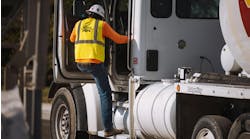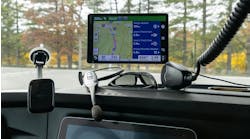Though data is essential for route optimization, the sheer amount can become overwhelming. ELDs and telematics systems produce thousands of data points each day, making it challenging to wade through, leaving fleet managers, route planners, and dispatchers overwhelmed.
Yet, Steve Kalnitzky, product manager at Trimble, a fleet technology company, said that route optimization efforts can be tackled simply: one goal at a time.
Consider a fleet that simply wants to track its drivers.
“If you're beholden to the ELD laws ... you're going to get [location] as a data capture element,” Kalnitzky said. “That's a good start because now you see what's happening already. Then that also leads to things like positioning: ‘I know where my customers are at, I know where the actual stop location is at, I know where my driver needs to stop.’”
While many fleets have access to thousands of data points, by tackling small goals at a time, such as in the example above, fleet managers and dispatchers will become less overwhelmed and understand that they don’t have to make sense of all the data at once.
“You need these small pieces of data that can help you meet your goals, and I don't think that necessarily means that you need all the data or none,” Kalnitzky told FleetOwner. “I think you can focus on small pieces of it.”
See also: The state of fleets in 2024 includes emphasis on business agility, data utilization
Ladders of optimization
A fleet unsure where to start its optimization journey can refer to what Kalnitzky calls the “ladders of optimization.”
“Ladders of optimization are essentially: ‘What’s the bare minimum I can do?’” Kalnitzky said.
The bottom rung of the optimization ladder in one fleet may be to plan routes manually with spreadsheets, ordering stops from closest to furthest; however, another fleet may be on the highest rung of the optimization ladder, using a complete system-generated solution with artificial intelligence or machine learning that “accounts for things like your dispatchers' quirks and your drivers’ preferences,” Kalnitzky explained.
This ladder concept can help fleets take tangible steps to accomplish one optimization goal at a time until they reach a fully automated solution. However, Kalnitzky said the key to adding better value and optimization through data—especially in a system-generated optimization platform—is to ensure good data quality. That should start at the bottom rung.
“Maybe you don’t have good time window data; maybe you don’t have good address data,” Kalnitzky said. “If you don’t feed the algorithm the right stuff, you’re not going to get a good answer that makes everybody happy.”
Mitigate the prevalence of poor data by talking to customers, paying attention to details, and comparing data points through different sources. Fleets using data obtained 10 years ago—a customer’s preferred delivery times, for example—might benefit from reaching out to ask if those times are still ideal.
See also: Transforming data into intelligence can give fleets the edge
Test optimization before a fleet-wide rollout
This process can seem intimidating and if done correctly will prove to be time-consuming and perhaps even expensive. But as Kalnitzky advised, optimization through data doesn’t have to be “all or nothing.”
“It doesn’t have to be a giant project,” he said. Fleets can spend one-quarter focusing on one goal, such as improving the accuracy of time windows, and then see if there’s an improvement in any metrics at the end of that three-month period, he said. This will help guide the fleet’s next steps.
Even fleets with the resources to make sweeping changes at once should still exercise caution when overhauling operations. Years ago, one Trimble customer wanted to change its routing from fixed to dynamic to increase efficiency, Kalnitzky recalled.
“They onboarded the software; we taught them dynamic routing,” he explained. “They came to us and said, ‘This is incredible. After two months, we’ve saved so much money!’ But then they started churning customers.”
This fleet company hadn’t met with its customers before rolling out its new routing solutions, leading its customers to experience different delivery times and frustrations with this fleet’s service. Trimble was able to help this company transition to a more hybrid routing system, incorporating both fixed routing to satisfy customers and dynamic routing to save money.
“You don’t eat a whole pizza at once—you eat a slice at a time,” Kalnitzky told FleetOwner. “The approach they should have taken was, ‘Let’s operate with the fixed route, let’s find some small areas for opportunity, let’s not eat that whole pizza at once.’”
See also: How one fleet used data to optimize its routing strategy
With the help of telematics providers, fleets can roll out optimization solutions across their entire fleet; however, for fleets that prefer to go it alone, as Trimble’s Kalnitzky said, all that’s required to get started is to simply pick a goal and get started.
There is no one-size-fits-all approach to route optimization. One fleet’s route optimization strategy could look vastly different from another, depending on the fleet's goals. In every fleet, however, there is room for better routing and better optimization.




